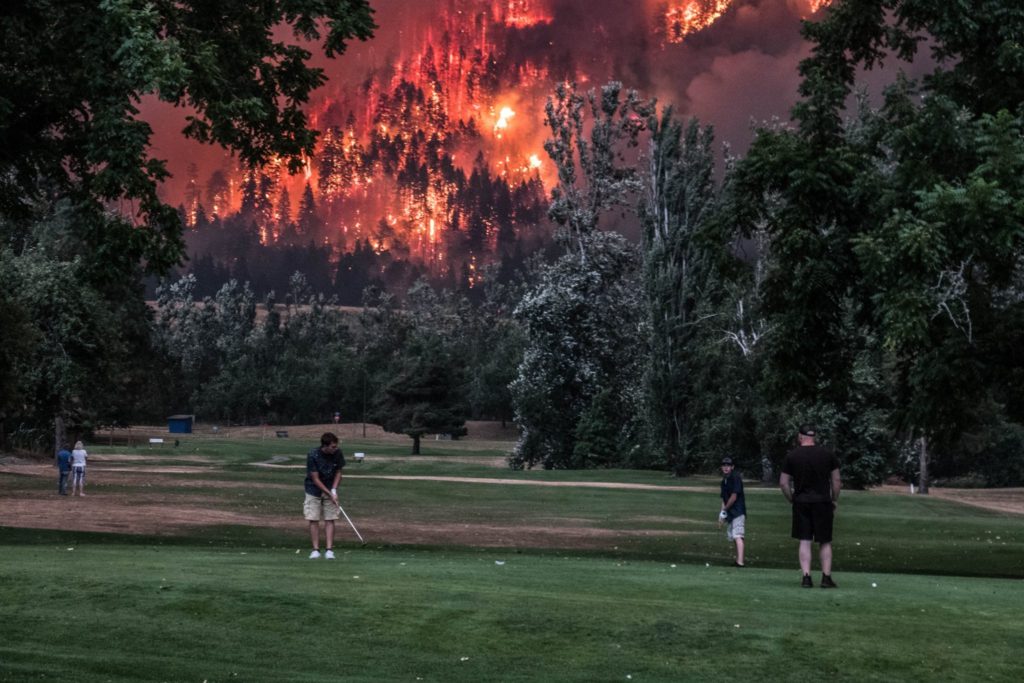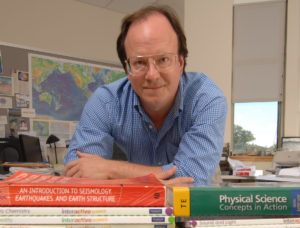
The photograph quickly went viral. A group of golfers in southern Washington State calmly putts before a raging forest fire.
First posted Sept. 6, the image — by amateur photographer Kristi McCluer — has taken social media by storm. It has been up-voted by more than 54,000 Reddit users, retweeted by screenwriter David Simon, and become the subject of news articles and countless memes.
But the point is this: In the western United States, forest fires have become so routine that people barely notice them anymore.

The relative lack of response to Hurricane Harvey — and to Hurricanes Irma, Katia, and Maria — is very much the same. For decades, climate scientists have been warning that warmer ocean temperatures will cause more powerful storms. Nine of the 10 most destructive U.S. hurricanes have happened since 2000.
And though it’s true that four major hurricanes in the space of two weeks is unusual enough to garner some news coverage, much of the public still yawns. Haven’t we seen this all before?
Yes, we have seen this all before. And we’ll continue to do so.
Something unusual is going on. And it’s critical that we both recognize this and refuse to allow ourselves to accept it as the new normal. We cannot simply shrug it all off and continue golfing while the world burns, or floods, because it all just feels too complicated.
But you can’t blame every forest fire or hurricane on global warming. Right?
Well, yes and no. One climate scientist used another sport to describe the difference between climate and weather. Marshall Shepherd, former president of the American Meteorological Society, pointed to the steroid era in baseball, when baseballs were flying out of stadiums and home run records were shattering right and left.
You couldn’t point to any single home run and know for sure whether or not steroids were the cause of it. But you sure knew that something out of the ordinary was happening.
Another climate scientist, Michael Mann, used a basketball metaphor to illustrate the destruction of Hurricane Sandy in 2012. Sandy’s flooding was amplified by the fact that global warming had raised the sea level south of Manhattan about a foot since previous centuries. Imagine lifting the floor of a basketball court up one foot, Mann explained. You’d get a lot more slam dunks.
Harvey was a slam dunk. So was Irma. And Maria. And the fact that much of the western United States is in flames.
But we can’t let ourselves get used to this. The people of Houston and Florida didn’t ignore it, fortunately. They couldn’t. And evacuations meant that few lives were lost, despite the billions of dollars in damages. Puerto Rico wasn’t as fortunate; it’s hard to evacuate an island. But outside the affected areas, too many people have simply shut their eyes. Harvey will end up costing more than Hurricane Katrina. Puerto Rico might not recover during our lifetimes. But so far, the responses have not measured up. Same for Irma. Same for the fires in the Pacific Northwest.
Yawn. Flip the channel, we’ve seen it before. Perhaps people will begin paying attention when rising sea levels entirely submerge Florida, or when the mouth of the Mississippi River reaches Illinois. Or perhaps not.
Wanna play some golf?
Michael E. Wysession is professor of earth and planetary sciences at Washington University in St. Louis